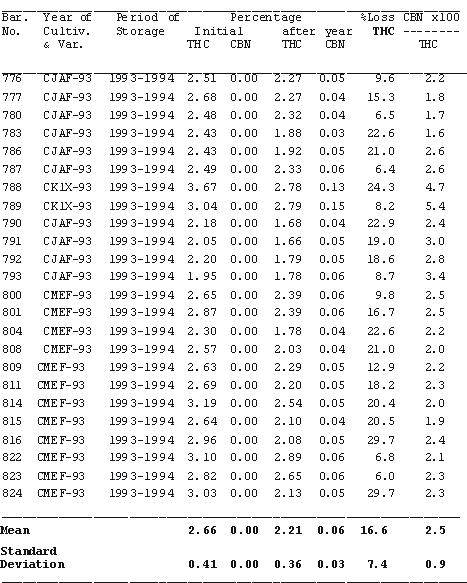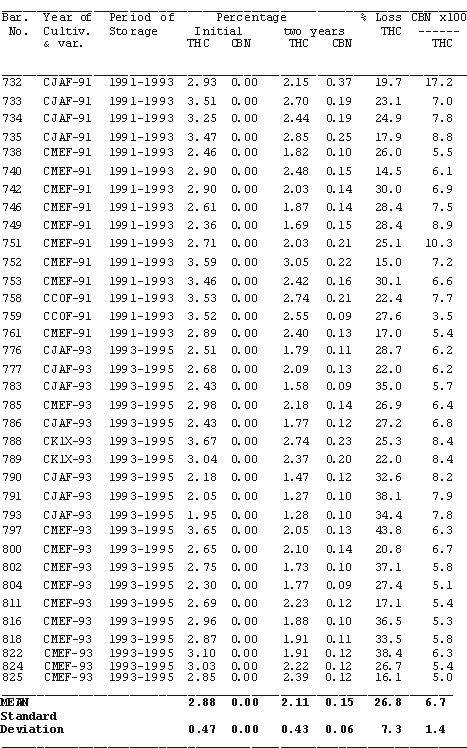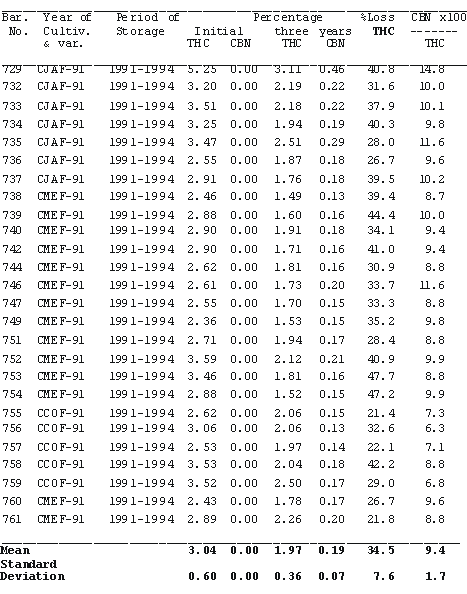ABSTRACT
Introduction
Experimental basis
Results and discussion
References
Author: S. A. ROSS, M. A. ELSOHLY
Creation Date: 1999/12/01
S. A. ROSS
National Center for the Development of Natural Products, Research Institute of Pharmaceutical Sciences, Department of Pharmacognosy, School of Pharmacy, University of Mississippi, Oxford, Mississippi, United States of America
M. A. ELSOHLY
National Center for the Development of Natural Products, Research Institute of Pharmaceutical Sciences, Department of Pharmaceutics, School of Pharmacy, University of Mississippi, Oxford, Mississippi, United States of America
The concentration of D9-tetrahydrocannabinol (THC) and cannabinol (CBN) in cannabis plant material (marijuana) of different varieties stored at room temperature (20-22o Celsius (C)) over a four-year period was determined. The percentage loss of THC was proportional to the storage time. On average, the concentration of THC in the plant material decreased by 16.6% ±7.4 of its original value after one year and 26.8% ±7.3, 34.5% ±7.6 and 41.4% ±6.5 after two, three and four years, respectively. A relationship between the concentration ratio of CBN to THC and the storage time was developed and could serve as a guide in determining the approximate age of a given marijuana sample stored at room temperature.
The stability of (-)-D9-tetrahydrocannabinol (D9-THC) has been the subject of several investigations (1-13). In 1970, Liskow (1) reported that marijuana deteriorates during storage at room temperature because of the loss of D9-THC at a rate of 3 to 5 per cent a month. Shoyama and others (3) were able to isolate cannabinolic acid (CBNA) from stored hemp but not from fresh hemp, and concluded that conversion of tetrahydrocannabinolic acid (THCA) to CBNA was effected by ultraviolet light and by storage and heat. The same conclusion was reached by Turner and others (4, 5), who reported that THC disappeared at a rate of 3.83, 5.38 and 6.92 per cent per year over two years when stored at -18o, 4o, and 22o C, respectively. The loss of THC was essentially complete at 37o C and 50o C. Fairbairn and others (6) reported that carefully prepared herbal or resin cannabis products are reasonably stable for one to two years if stored in the dark at room temperature.
Razdan and others (2) found thatD9-THC is much less stable than D8-THC and is converted mainly to CBN. The degradation of D9-THC to CBN in the plant material on storage was also proposed by Waller and others (7), Razdan and others (8), El-Kheir and others (9), Hanus and others (10) and Yotoriyana and others (11). Although CBN is the major observed decomposition product of THC, it could not account for the decrease in the concentration of THC over a period of time when the latter is kept under conditions suitable for decomposition (12). Turner and ElSohly (13) addressed this problem and proposed a possible pathway for the decomposition of THC to CBN which involvesformation of epoxy and hydroxylated intermediates. These include 9,10-dihydroxy-D6a(10a)-THC (racemic mixture) and 8,9-dihydroxy- D6a(10a)-THC (racemic mixture). They found that these intermediates could be detected only by gas chromatography as their trimethyl silyl (TMS) derivatives. They also indicated that these compounds were susceptible to heat and acid and that the final product was CBN.
In the present report, the change in the level of THC and CBN in stored marijuana was studied over a four-year period. THC and CBN were analysed annually in marijuana stored at room temperature and a correlation was developed between the ratio of CBN to THC and the age of the plant material. The empirical correlation could be used to estimate the age of a given marijuana sample.
Plant material
The plant material used in the study was grown at the University of Mississippi medicinal plant garden. Mature plants were harvested and dried in a drying barn. The temperature was set initially at 50o C and was then increased at 2.5o C per hour until 70o C was reached. Under those conditions, dryness was complete within 6-8 hours. The dried materials were then coarsely manicured, packed in closed barrels and stored in an air-conditioned vault.
Plants used in the study were grown from seeds of Colombian, Jamaican, Mexican or hybrid varieties.
Storage conditions
The dried plant material was stored in closed barrels in the dark in a secured air-conditioned vault. Room temperature fluctuated slightly over time but generally remained between 20o and 22o C. Samples were obtained annually from stored material for cannabinoid analysis.
Analytical procedure
The method used for analysis has been previously described by Ross and others (14). Briefly, each dried sample was manicured by passing through a metal sieve (number 14). One hundred milligrams (mg) of each sample was weighed and extracted with 3 millilitres (ml) of extraction solution (internal standard), which was a mixture of 100 mg of 4-androstene-3,17-dione, 10 ml of chloroform and 90 ml of methanol. After the samples were allowed to stand for one hour, the extracts were separately removed from each flask and transferred into screw-cap vials, from which aliquots were transferred into 2-ml gas-chromatography vials.
Gas-chromatography analysis
A chromatograph, model 5880A, equipped with an automatic liquid sampler, model 7673, was used under the following conditions: (a) column: DB-1, 15 m × 0.25 mm, with 0.25 µm film thickness; (b) temperature: initial, 170o C for 1 minute then programmed to 250o C at the rate of 10o C/min; (c) injector temperature: 240o C; (d) detector temperature: 260o C; (e) carrier gas: helium at approximately 1 ml/min; and (f) detector: flame ionization detector with hydrogen flow rate of 30 ml/min and air flow rate of 300 ml/min. Each sample was analysed in duplicate and the average percentage for THC and CBN was calculated. The results are summarized in tables 1-4.
Table 1. Concentration of THC and CBN in marijuana samples stored
for one year at room temperature

a The varieties and year of cultivation were as follows: CJAF-93: cultivated Jamaican variety, female, 1993; CK1X-93: cultivated hybrid, mixture, 1993; and CMEF-93: cultivated Mexican variety, female, 1993.
Table 2. Concentration of THC and CBN in marijuana samples stored
for two years at room temperature

a The varieties and years of cultivation were as follows: CJAF-91: cultivated Jamaican variety, female, 1991; CMEF-91: cultivated Mexican variety, female, 1991; CCOF-91: cultivated Colombian variety, female, 1991; CK1X-93: cultivated hybrid, mixture, 1993.
Table 3. Concentration of THC and CBN in marijuana samples stored for three years at room temperature

a The varieties and years of cultivation were as follows: CJAF-91: cultivated Jamaican variety, female, 1991; CMEF-91: cultivated Mexican variety, female, 1991; CCOF-91: cultivated Colombian variety, female, 1991.
Table 4. Concentration of THC and CBN in marijuana samples
stored for four years at room temperature

a The varieties and years of cultivation were as follows: CCOF-91: cultivated Colombian variety, female, 1991; CMEF-91: cultivated Mexican variety, female, 1991; CK1F-91 cultivated hybrid, female, 1991; CJAF-91: cultivated Jamaican variety, female, 1991; CMEF-91: cultivated Mexican variety, female, 1991.
Determination of the age of a marijuana sample is often required in forensic work, and to date there is no reported method to estimate it.Since D9-THC is known to oxidize to CBN over time, the presence of CBN in a marijuana sample indicates that the sample is not fresh. It is presumed that the higher the amount of CBN, the older the sample. In an effort to correlate between the amount of CBN and THC as they relate to the age of marijuana samples, the present study was carried out.
The dried marijuana samples produced from different cannabis crops of different varieties were stored at room temperature and were analysed shortly after harvesting (time 0) and yearly thereafter for up to four years. Tables 1-4 show the concentration of both THC and CBN at time 0 and after one, two, three and four years of storage, respectively. The percentage loss of THC in each case is also presented along with the amount of CBN relative to THC (percentage) after each storage period.
Figure I shows the relationship between the percentage loss of THC and the storage time. Although it is clear that there was a wide variation in the percentage loss at each data point (standard deviation of 6.5-7.6 per cent), the percentage loss of THC was proportional to the storage time. On the average, the concentration of THC in the plant material decreased by 16.6% ±7.4 of its original value after one year, 26.8% ±7.3 after two years, 34.5% ±7.6 after three years and 41.4% ±6.5 after four years.
Figure I. Relationship between the percentage loss of THC
and years of storage

Several attempts were made to develop a relationship between the time of storage and the concentration of THC and CBN. It was found that the percentage ratio of CBN to THC at the time of analysis was most predictive of the age of the plant material. Tables 1-4 show the values for all samples stored for one, two, three and four years, respectively. On average, the percentage ratio of CBN to THC was found to be 2.5 ±0.9, 6.7 ±1.4, 9.4 ±1.7 and 14.2 ±1.2 for samples stored for one, two, three and four years respectively, as reflected in figure II.
A number of observations were made. First, not all of the THC converts directly to CBN, suggesting other intermediates in that process as previously described by Turner and ElSohly (13). Secondly, CBN does not exist in the freshly and carefully dried marijuana, supporting previous reports (3, 4). Thirdly, the degradation of THC appears to proceed at a higher rate for the first year than subsequent years and levels off after two years to a rate of loss of approximately 7 per cent per year. Therefore, studies carried out with "old" material could feasibly report a 7 per cent loss per year. It is believed that the percentage loss in THC content is also a function of the initial THC concentration. The higher the concentration of THC, the faster the degradation over the first one or two years. That could account for the high variability in the percentage loss in THC over time in the samples represented by several varieties used in the present study.
The results reported above show that it is feasible to determine the age of a given marijuana sample on the basis of its THC and CBN contents, assuming that storage was carried out at room temperature. It is evident from figure II that samples with a ratio of CBN to THC of less than 0.013 are less than six months old, and those with a ratio of between 0.04 and 0.08 are between one and two years old. Figure II could be used to estimate the age of a given sample on the basis of the concentration of CBN and THC.
Figure II. Relationship between the percentage ratio of
CBN to THC and years of storage

It should be emphasized, however, that variations from the experimental conditions described in the present report should be considered in the interpretation of the analytical results.
1. B. Liskow, "Marihuana deterioration", J. Amer. Med. Ass., vol. 214, No. 9 (1970), pp. 1709-1714.
2. R. K. Razdan and others, "Studies onD8- and D9-tetrahydrocannabinoids", in report to the Committee on Problems of Drug Dependence, National Academy of Sciences, National Research Council, Division of Medical Sciences, Washington, D.C. (1970), pp. 6860-6867.
3. Y. Shoyama, T. Yamauchi and I. Nishioka, "Cannabis V., cannabigerolic acid, monomethyl ether and cannabinolic acid", Chem. Pharm. Bull., vol. 18, No. 7 (1970),pp. 1327-1332 .
4. C. E. Turner and others, "Constituents of Cannabis sativa L.: X. Cannabinoid profile of a Mexican variant and its possible correlation to pharmacological activity", Acta Pharm. Jugosl., vol. 25 (1975), pp. 7-16.
5. C. E. Turner and others, "Constituents of Cannabis sativa L.: IV. Stability of cannabinoids in stored plant material", J. Pharm. Sci., vol. 62, No. 10 (1973), pp. 1601-1605.
6. J. W. Fairbairn, J. A. Liebmann and M. G. Rowan, "The stability of cannabis and its preparations on storage", J. Pharm. Pharmac., vol. 28 (1976), pp. 1-7.
7. C. W. Waller, J. B. Johnson and C. E. Turner, "Marihuana: an annotated bibliography", Macmillan Information, New York (1976).
8. R. K. Razdan and others, "Hashish. VI. Conversion of (-)-i1(6)-tetrahydrocannabinol to (-)-i1(7)-tetrahydrocannabinol: stability of (-)-i1(6)-tetra- hydrocannabinols; Experientia, vol. 28, No. 2 (1972), pp. 121-122.
9. Y. M. El-Kheir, M. I. Mohamed and H. A. Hakim, "Stability of cannabis preparation on storage", Fitoterapia, vol. 57, No. 4 (1986), pp. 235-237.
10. L. Hanus, K. Tesarik, and Z. Krejci, "Capillary gas chromatography of natural substances from Cannabis sativa L.: I. Cannabinol and cannabinolic acid-artefacts, Acta Univ. Palacki. Olomuc. Fac. Med., vol. 108 (1985), pp. 29-38.
11. M. Yotoriyama, "The decrease of tetrahydrocannabinolic acid (THCA) in cannabis leaves during storage", Eisei Kaguaku, vol. 26, No. 1 (1980), pp. 50-53.
12. G. S. Lewis and C. E. Turner, "Constituents of Cannabis sativa L.: XIII. Stability of dosage form prepared by impregnating synthetic (-)-D9-trans-tetrahydrocannabinol on placebo cannabis plant material", J. Pharm. Sci., vol. 67, No. 6 (1978), pp. 876-878.
13. C. E. Turner and M. A. ElSohly, "Constituents of Cannabis sativa L.: XVI. A possible decomposition pathway of D9-tetrahydrocannabinol to cannabinol", J. Heterocyclic Chem., vol. 37 (1979), pp. 1667-1668.
14. S. A. Ross and others, "The analysis of confiscated marijuana samples for different cannabinoids using GC-FID", American Laboratory, vol. 16F (1995), p.21.
* Study supported in part by the National Institute on Drug Abuse of the United States of America.